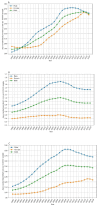Burden of opioid use disorder in the Middle East and North Africa (MENA): findings from Global Burden of Disease (GBD) study
- PMID: 40826480
- PMCID: PMC12363103
- DOI: 10.1186/s41043-025-01029-4
Burden of opioid use disorder in the Middle East and North Africa (MENA): findings from Global Burden of Disease (GBD) study
Abstract
Background: Opioid Use Disorders (OUDs) present critical health challenges across the Middle East and North Africa (MENA) region. The primary objective of this study is to assess the prevalence and burden of OUDs within the MENA region.
Methods: In the current study, we used the Global Burden of Diseases (GBD) 2019 study data. In the GBD study, OUDs were defined as the ICD-10 codes of F11.0-F11.9, P96.1, and R78.1 and the DSM-IV (Diagnostic and Statistical Manual of Mental Disorders, Fourth Edition) code of 304.00. We retrieved the prevalence, death, and disability-adjusted life year (DALY) crude rates and age-standardized rates for OUDs throughout MENA countries, the MENA area, and globally, across years (from 1990 to 2019), genders, and age groups.
Results: Age-standardized DALY rate of OUDs in MENA increased by 40.6%, from 104.4 (95% UI: 78.2-136.0) in 1990 to 147.0 (95% UI: 111.8-187.7) per 100,000 people in 2019. In 2019, the highest DALY rate of OUDs for both males (411.3 per 100000) and females (330.2 per 100000) and in total (372.3 per 100000) was in the 25-29 years age group. In 2019, the highest age-standardized DALY rates of OUDs were UAE (373.9 per 100000, 95% UI: 278.2-481.7), Libya (341.1 per 100000, 95% UI: 248.9-435.8), and Iran (281.5 per 100000, 95% UI: 221.1-349.0). Age-standardized DALY rates decreased in Qatar (-10.2%) and Iraq (-1.9%) from 1990 to 2019. While, age-standardized DALY rates increased in other countries, with the highest increases being in Libya (167.3%), Lebanon (121.1%), and UAE (113.31%).
Conclusions: The burden of OUDs has increased from 1990 to 2019 in the MENA region. These results necessitate new governmental policies and global collaborations to effectively control opioid production and trafficking and manage their negative health-related outcomes.
Keywords: Burden; Epidemiology; Middle east; North africa; Opioid use disorders.
© 2025. The Author(s).
Conflict of interest statement
Declarations. Ethics approval and consent to participate: N/A. Consent for publication: N/A. Competing interests: ANA is an editor of the Journal of Health, Population, and Nutrition, and one of the editors of the collection, Non-Communicable Diseases, Challenges and Solution, but he had no role in the peer review process of this paper. Other authors declare that they have no competing interests.
Figures




Similar articles
-
Burden of knee osteoarthritis in China and globally: 1990-2045.BMC Musculoskelet Disord. 2025 Jul 1;26(1):582. doi: 10.1186/s12891-025-08858-8. BMC Musculoskelet Disord. 2025. PMID: 40598022 Free PMC article.
-
Prescription of Controlled Substances: Benefits and Risks.2025 Jul 6. In: StatPearls [Internet]. Treasure Island (FL): StatPearls Publishing; 2025 Jan–. 2025 Jul 6. In: StatPearls [Internet]. Treasure Island (FL): StatPearls Publishing; 2025 Jan–. PMID: 30726003 Free Books & Documents.
-
Global, regional, and national burden of maternal disorders, 1990-2021: a systematic analysis from the global burden of disease study 2021.BMC Public Health. 2025 Jul 29;25(1):2576. doi: 10.1186/s12889-025-23814-w. BMC Public Health. 2025. PMID: 40730990 Free PMC article.
-
Estimates of the prevalence of autism spectrum disorder in the Middle East and North Africa region: A systematic review and Meta-Analysis.BMC Public Health. 2025 Jul 21;25(1):2519. doi: 10.1186/s12889-025-23651-x. BMC Public Health. 2025. PMID: 40691829 Free PMC article.
-
HIV among people who inject drugs in the Middle East and North Africa: systematic review and data synthesis.PLoS Med. 2014 Jun 17;11(6):e1001663. doi: 10.1371/journal.pmed.1001663. eCollection 2014 Jun. PLoS Med. 2014. PMID: 24937136 Free PMC article.
References
-
- Duarte DF. Opium and opioids: a brief history. Revista Brasileira De Anestesiologia. 2005;55:135–46. - PubMed
-
- Degenhardt L, Charlson F, Mathers B, Hall WD, Flaxman AD, Johns N, et al. The global epidemiology and burden of opioid dependence: results from the global burden of disease 2010 study. Addiction. 2014;109(8):1320–33. - PubMed
-
- Cicero TJ, Ellis MS, Kasper ZA. Increases in self-reported Fentanyl use among a population entering drug treatment: the need for systematic surveillance of illicitly manufactured opioids. Drug Alcohol Depend. 2017;177:101–3. - PubMed
MeSH terms
LinkOut - more resources
Full Text Sources
Medical
Research Materials
Miscellaneous

